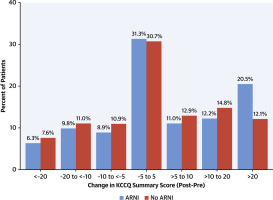JACC: Heart Failure ( IF 10.3 ) Pub Date : 2019-09-11 , DOI: 10.1016/j.jchf.2019.05.016 Yevgeniy Khariton 1 , Gregg C Fonarow 2 , Suzanne V Arnold 1 , Ann Hellkamp 3 , Michael E Nassif 4 , Puza P Sharma 5 , Javed Butler 6 , Laine Thomas 3 , Carol I Duffy 5 , Adam D DeVore 7 , Nancy M Albert 8 , J Herbert Patterson 9 , Fredonia B Williams 10 , Kevin McCague 5 , John A Spertus 1

|
Objectives
This study sought to describe the short-term health status benefits of angiotensin-neprilysin inhibitor (ARNI) therapy in patients with heart failure and reduced ejection fraction (HFrEF).
Background
Although therapy with sacubitril/valsartan, a neprilysin inhibitor, improved patients’ health status (compared with enalapril) at 8 months in the PARADIGM-HF (Prospective Comparison of ARNI with ACE inhibitor to Determine Impact on Global Mortality and Morbidity in Heart Failure) study, the early impact of ARNI on patients’ symptoms, functions, and quality of life is unknown.
Methods
Health status was assessed by using the 12-item Kansas City Cardiomyopathy Questionnaire (KCCQ) in 3,918 outpatients with HFrEF and left ventricular ejection fraction ≤40% across 140 U.S. centers in the CHAMP-HF (Change the Management of Patients with Heart Failure) registry. ARNI therapy was initiated in 508 patients who were matched 1:2 to 1,016 patients who were not initiated on ARNI (no-ARNI), using a nonparsimonious time-dependent propensity score (6 sociodemographic factors, 23 clinical characteristics), prior KCCQ overall summary (KCCQ-OS) score, and angiotensin-converting enzyme inhibitor/angiotensin receptor blocker status.
Results
Multivariate linear regression demonstrated a greater mean improvement in KCCQ-OS in patients initiated on ARNI therapy (5.3 ± 19 vs. 2.5 ± 17.4, respectively; p < 0.001) over a median (interquartile range [IQR]) of 57 (32 to 104) days. The proportions of ARNI versus no-ARNI groups with ≥10-point (large) and ≥20-point (very large) improvements in KCCQ-OS were 32.7% versus 26.9%, respectively, and 20.5% versus 12.1%, respectively, consistent with numbers needed to treat of 18 and 12, respectively.
Conclusions
In routine clinical care, ARNI therapy was associated with early improvements in health status, with 20% experiencing a very large health status benefit compared with 12% who were not started on ARNI therapy. These findings support the use of ARNI to improve patients’ symptoms, functions, and quality of life.
中文翻译:

射血分数降低的心力衰竭患者中沙必比尔/缬沙坦起始与健康状况结局之间的关联。
目标
这项研究试图描述血管紧张素-中性溶素抑制剂(ARNI)治疗心力衰竭和射血分数降低(HFrEF)患者的短期健康状况。
背景
尽管在PARADIGM-HF(ARNI与ACE抑制剂进行前瞻性比较以确定对全球死亡率和心力衰竭发病率的影响)研究中,中性溶酶抑制剂沙比特利/缬沙坦的治疗在8个月时改善了患者的健康状况(与依那普利相比)。 ,ARNI对患者症状,功能和生活质量的早期影响尚不清楚。
方法
通过使用12项堪萨斯城心肌病问卷(KCCQ)在CHAMP-HF(更改心力衰竭患者管理)登记册中的140个美国中心,对3,918名HFrEF和左心室射血分数≤40%的门诊患者进行健康状况评估。使用非简约的时间依赖性倾向评分(6个社会人口学因素,23个临床特征),先前的KCCQ总体总结,对508例未按ARNI(no-ARNI)进行了配比的1:2至1,016例患者进行了ARNI治疗。 (KCCQ-OS)得分,以及血管紧张素转换酶抑制剂/血管紧张素受体阻滞剂的状态。
结果
多元线性回归表明,在接受ARNI治疗的患者中,KCCQ-OS的平均改善幅度更大(分别为5.3±19 vs. 2.5±17.4; p <0.001),中位数(四分位数范围[IQR])为57(32至104) ) 天。在KCCQ-OS中,≥10分(大)和≥20分(非常大)的ARNI组与非ARNI组的比例分别为32.7%对26.9%,以及20.5%对12.1%,是一致的需要分别处理18和12的数字。
结论
在常规临床护理中,ARNI治疗与健康状况的早期改善相关,其中20%的人享有非常大的健康状况收益,而未开始使用ARNI治疗的人为12%。这些发现支持使用ARNI改善患者的症状,功能和生活质量。











































 京公网安备 11010802027423号
京公网安备 11010802027423号